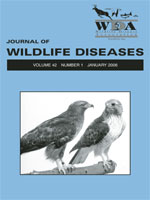Increased American alligator (Alligator mississippiensis) embryo and neonatal mortality has been reported from several northcentral Florida lakes contaminated with old-use organochlorine pesticides (OCPs). However, a clear relationship among these contaminants and egg viability has not been established, suggesting the involvement of additional factors in these mortalities. Thus, the main objective of this study was to determine the ultimate cause of mortality of American alligator late-stage embryos and hatchlings through the conduction of detailed pathological examinations, and to evaluate better the role of OCPs in these mortalities. Between 2000 and 2001, 236 dead alligators were necropsied at or near hatching (after ∼65 days of artificial incubation and up to 1 mo of age posthatch). Dead animals were collected from 18 clutches ranging in viability from 0% to 95%. Total OCP concentrations in yolk ranged from ∼100 to 52,000 μg/kg, wet weight. The most common gross findings were generalized edema (34%) and organ hyperemia (29%), followed by severe emaciation (14%) and gross deformities (3%). Histopathologic examination revealed lesions in 35% of the animals, with over half of the cases being pneumonia, pulmonary edema, and atelectasis. Within and across clutches, dead embryos and hatchlings compared with their live cohorts were significantly smaller and lighter. Although alterations in growth and development were not related to yolk OCPs, there was an increase in prevalence of histologic lesions in clutches with high OCPs. Overall, these results indicate that general growth retardation and respiratory abnormalities were a major contributing factor in observed mortalities and that contaminants may increase the susceptibility of animals to developing certain pathologic conditions.
How to translate text using browser tools
1 January 2006
NECROPSY FINDINGS IN AMERICAN ALLIGATOR LATE-STAGE EMBRYOS AND HATCHLINGS FROM NORTHCENTRAL FLORIDA LAKES CONTAMINATED WITH ORGANOCHLORINE PESTICIDES
María S. Sepúlveda,
Fabio Del Piero,
Jonathan J. Wiebe,
Heath R. Rauschenberger,
Timothy S. Gross

Journal of Wildlife Diseases
Vol. 42 • No. 1
January 2006
Vol. 42 • No. 1
January 2006
Alligator mississippiensis
contaminants
embryos
Hatchlings
histopathology
necropsy
toxicology




